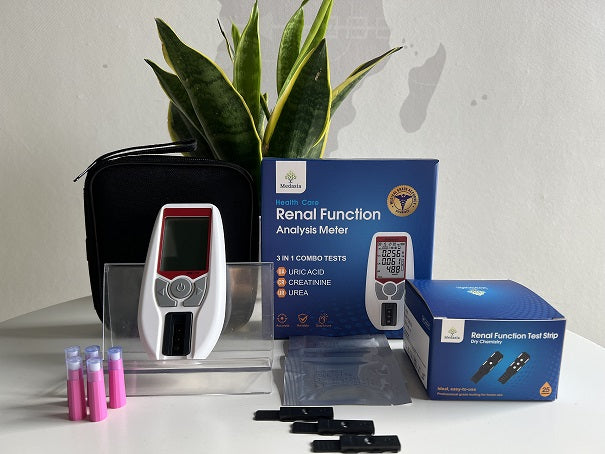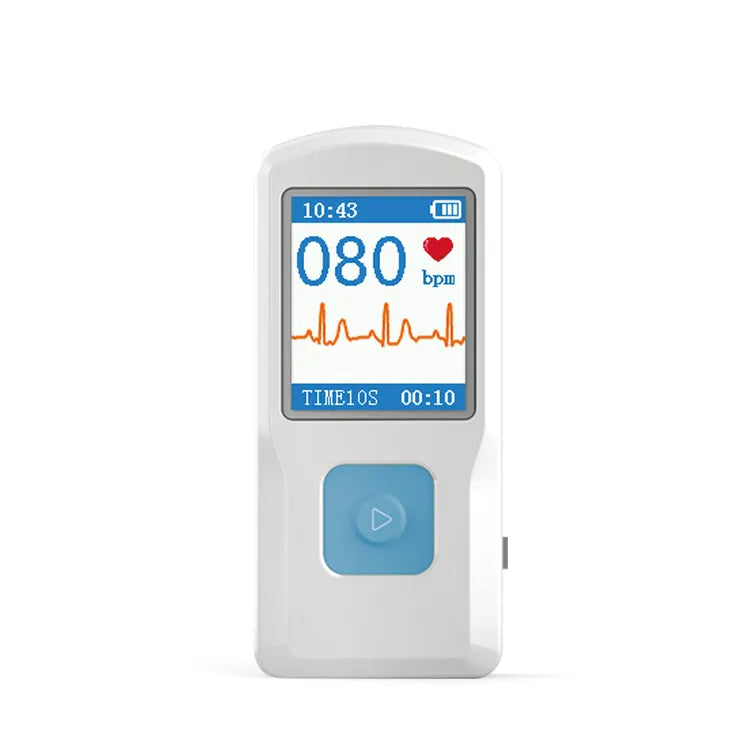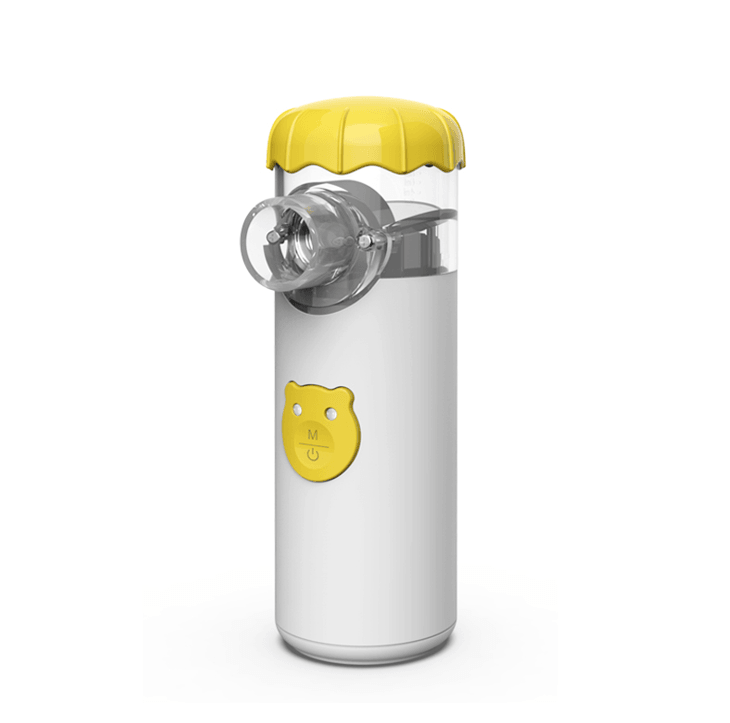Nuevas herramientas para detectar la enfermedad renal fuera del hospital


Datos globales: sobre la enfermedad renal
La enfermedad renal es un problema significativo de salud pública a nivel mundial. La lesión renal aguda (LRA) y la enfermedad renal crónica (ERC) están vinculadas a altos costos de atención médica, mala calidad de vida y graves resultados adversos para la salud. El 10% de la población mundial se ve afectada por la enfermedad renal crónica (ERC), y millones mueren cada año porque no tienen acceso a un tratamiento asequible. Más de 2 millones de personas en todo el mundo reciben actualmente tratamiento con diálisis o un trasplante de riñón para mantenerse con vida, sin embargo, este número puede representar solo el 10% de las personas que realmente necesitan tratamiento para vivir. En personas de 65 a 74 años en todo el mundo, se estima que uno de cada cinco hombres y una de cada cuatro mujeres tienen ERC. Las enfermedades no transmisibles (como las enfermedades cardíacas, la diabetes o la enfermedad renal) han reemplazado a las enfermedades transmisibles (como la influenza, la malaria o el SIDA) como las causas más comunes de muerte prematura en todo el mundo. Se estima que el 80% de esta carga ocurre en países de ingresos bajos o medios, y el 25% en personas menores de 60 años.
Los tipos más comunes de enfermedad renal
- enfermedad renal crónica: Una causa importante de la enfermedad renal crónica es la hipertensión arterial. Debido a que los riñones procesan constantemente la sangre del cuerpo, procesan el 20 % del total de la sangre cada minuto. La hipertensión arterial es peligrosa para los riñones porque puede aumentar la presión en el glomérulo, su unidad funcional. Con el tiempo, esta presión alta puede dañar la unidad de filtración del riñón y su función se verá afectada.
- cálculos renalesLos minerales y otras sustancias de la sangre pueden cristalizarse en los riñones, formando partículas sólidas o cálculos, que suelen excretarse en la orina. La excreción de cálculos renales puede ser muy dolorosa, pero rara vez causa problemas graves.
- GlomerulonefritisLa glomerulonefritis es un tipo de enfermedad renal que afecta a los diminutos filtros de los riñones (glomérulos). El exceso de líquido y desechos que los glomérulos eliminan del torrente sanguíneo se expulsan del cuerpo en forma de orina. Puede aparecer de forma repentina (aguda) o gradual (crónica).
- Poliquistosis renalLos tipos de enfermedad renal poliquística también pueden causar la formación de quistes en el hígado y otras partes del cuerpo. Esta enfermedad puede causar complicaciones graves, como hipertensión arterial e insuficiencia renal.
¿Por qué es importante controlar la función renal?
El funcionamiento correcto de los riñones se conoce como función renal. Los riñones tienen la importante función de filtrar la sangre. Eliminan los desechos y el exceso de líquido del cuerpo. Cuando los riñones no funcionan correctamente, los desechos pueden acumularse en la sangre. Esto puede causarle enfermedades. Si padece enfermedad renal crónica (de larga duración), es posible que no presente síntomas hasta que su función renal sea muy baja. Los análisis de sangre y orina pueden ayudar a determinar el funcionamiento correcto de los riñones. Estos pueden ayudar a su médico a conocer mejor su cuerpo.
El tema de este artículo
Este artículo busca destacar los beneficios de los productos para la función renal y su papel crucial en el apoyo a las personas con enfermedades renales. La enfermedad renal crónica tiene tratamiento. Con un diagnóstico y tratamiento tempranos, es posible retrasar o detener su progresión.
La empresa de Medasia
Medasia Se dedica a promover la accesibilidad global a la atención médica, empoderando a las personas a través del autocuidado. Nuestra ambición es garantizar que personas de todo el mundo tengan los medios y el conocimiento para tomar las riendas de su bienestar.
MedasiaImpulsados por la innovación, nos especializamos en autoevaluaciones para diversas afecciones médicas. Ofrecemos productos que permiten a las personas gestionar su salud de forma proactiva, cómoda e independiente. Dé el primer paso hacia un futuro más saludable con nosotros.
Para obtener más información, visite www.medasiagroup.com
Objetivos de la función renal
1.Resultados normales de la prueba de ácido úrico
La mayoría de los adultos pierden entre 500 y 600 miligramos de ácido úrico en la orina cada 24 horas. Más de 800 miligramos es demasiado si se lleva una dieta normal.
2.Resultados normales de la prueba de creatinina
La creatinina suele entrar en el torrente sanguíneo y se filtra a un ritmo generalmente constante. La cantidad de creatinina en sangre debería ser relativamente estable. Un nivel elevado de creatinina puede ser un signo de insuficiencia renal.
La creatinina sérica se expresa en miligramos de creatinina por decilitro de sangre (mg/dL) o micromoles de creatinina por litro de sangre (micromoles/L). El rango típico para la creatinina sérica es: Para hombres adultos, 0,74 a 1,35 mg/dL (65,4 a 119,3 micromoles/L) Para mujeres adultas, 0,59 a 1,04 mg/dl (52,2 a 91,9 micromoles/L).
3.Resultados normales de la prueba de urea
Los valores normales varían de 12 a 20 gramos por 24 horas (428,4 a 714 mmol/día). Los rangos de valores normales pueden variar ligeramente entre diferentes laboratorios. Algunos utilizan diferentes medidas o analizan muestras diferentes. Consulte con su médico sobre el significado de los resultados específicos de su prueba.
¿Con qué frecuencia es necesario medir la TFGe?
- anualmente en todos los grupos de riesgo
- Durante enfermedades intercurrentes y en el perioperatorio en todos los pacientes con ERC. La frecuencia exacta dependerá de la situación clínica. La frecuencia de las pruebas puede reducirse si los niveles de eGFR se mantienen muy estables, pero será necesario aumentarla si se observa una progresión rápida.

Referencia:
(1) The Renal Association (mayo de 2006). Directrices sobre enfermedad renal crónica del Reino Unido.
(2) NICE (septiembre de 2008). Enfermedad renal crónica: Identificación temprana y tratamiento de la enfermedad renal crónica en adultos en atención primaria y secundaria.
Ámbito de aplicación del uso de un medidor de riñón

Para organizaciones:
1.Hospitales: Los glucómetros se utilizan ampliamente en hospitales para medir la función renal mediante pruebas como la creatinina sérica y la tasa de filtración glomerular estimada (TFGe). Estas mediciones ayudan a los profesionales sanitarios a diagnosticar la lesión renal aguda, la enfermedad renal crónica y otros trastornos renales. También orientan las decisiones terapéuticas y monitorizan la salud renal de los pacientes durante su estancia hospitalaria.
2.Institutos de investigación: Los institutos de investigación utilizan medidores renales para realizar estudios relacionados con enfermedades renales, fisiología renal y desarrollo de fármacos. Estos dispositivos ayudan a los investigadores a recopilar datos para ensayos clínicos, estudios epidemiológicos y otros proyectos de investigación centrados en la salud renal.
3. Ministerio de Salud (MOH): Los medidores de riñón desempeñan un papel importante en las iniciativas de salud pública llevadas a cabo por el Ministerio de Salud. Se utilizan en programas de detección masiva para evaluar la función renal en poblaciones específicas e identificar a individuos con riesgo de padecer enfermedad renal.
4.Clínicas: Los glucómetros renales son comunes en clínicas y centros de atención primaria. Son herramientas esenciales para evaluar la función renal durante las revisiones rutinarias y para el seguimiento de pacientes con enfermedades renales diagnosticadas.
5.Farmacias: En ciertos centros de salud, las farmacias pueden ofrecer pruebas de función renal en el punto de atención mediante medidores de función renal. Estas pruebas pueden proporcionar a los pacientes información inmediata sobre su salud renal, ayudándoles a comprender sus factores de riesgo y a buscar atención médica adicional si es necesario.
6. Centros de función renal: Los centros especializados dedicados a las pruebas y el manejo de la función renal utilizan ampliamente medidores de riñón. Estos centros ofrecen evaluaciones integrales de la función renal y guían a los pacientes en el manejo de enfermedades renales crónicas.
7.Centros de Examen Físico: Los medidores de función renal se utilizan comúnmente en centros de reconocimiento médico para evaluar la función renal como parte de una evaluación general de salud. Esta información es valiosa para identificar a personas con posibles problemas renales y orientar evaluaciones posteriores.
Para particulares:
1. Médico general (GP): Los médicos de cabecera pueden usar medidores de función renal para evaluar la función renal durante las revisiones rutinarias o al investigar síntomas que puedan indicar problemas renales. Estas mediciones ayudan a la detección temprana y al tratamiento oportuno de las afecciones renales.
2.CardiólogoLa función renal está estrechamente relacionada con la salud cardiovascular. Los cardiólogos pueden utilizar medidores de función renal para evaluar la función renal en pacientes con afecciones cardíacas y determinar planes de tratamiento adecuados que consideren tanto la salud cardíaca como la renal.
3. OftalmólogoPara los oftalmólogos, los medidores de riñón pueden ser valiosos para evaluar la función renal como parte de las evaluaciones generales de salud de pacientes con ciertas afecciones oculares, como la retinopatía diabética o la retinopatía hipertensiva, que pueden estar relacionadas con la enfermedad renal.
4.Especialista en función renalComo especialistas en enfermedades renales, estos profesionales utilizan medidores de función renal para monitorear y evaluar la función renal en pacientes con enfermedad renal crónica, cálculos renales u otros trastornos renales. Estas mediciones orientan las decisiones terapéuticas y ayudan en el manejo de la enfermedad.
5. EnfermeraEl personal de enfermería puede usar medidores de función renal para realizar pruebas de función renal, lo que proporciona información crucial durante las evaluaciones y los exámenes de salud de los pacientes. El monitoreo regular de la función renal permite al personal de enfermería detectar signos tempranos de problemas renales y apoyar la atención integral de los pacientes.
6.DietistaLa función renal influye en la determinación de las recomendaciones dietéticas, especialmente para pacientes con enfermedad renal. Los medidores renales ayudan a los dietistas a adaptar los planes de nutrición que favorecen la salud renal, considerando las necesidades dietéticas individuales.
7.EndocrinólogoLa función renal es esencial en pacientes con trastornos endocrinos, como diabetes o enfermedades tiroideas. Los endocrinólogos pueden utilizar medidores renales para evaluar la salud renal y su impacto en la función endocrina general.
8.FarmacéuticoEn ciertos entornos sanitarios, los farmacéuticos pueden realizar pruebas de función renal en el punto de atención mediante medidores de función renal. Esto ayuda a identificar a los pacientes con riesgo de disfunción renal y facilita el manejo de la medicación según la función renal.
9. Educador RenalLos medidores renales son herramientas valiosas para los educadores renales, ya que les permiten realizar pruebas de función renal durante las sesiones educativas. Esto ayuda a evaluar la eficacia de la educación y las intervenciones en el estilo de vida para promover la salud renal.

¿Cómo elegir el mejor medidor de riñón?
Elegimos varios productos relacionados con la función renal para comparar. Al comparar las ventajas y desventajas de la función, finalmente elija el mejor medidor de función renal.
1. Prueba de riñón casera 6 en 1 de Choose Health

Este tipo de prueba renal, que se realiza mediante punción digital, solo requiere un par de gotas de sangre para su análisis. La muestra se envía para su análisis en el sobre prepagado incluido en el kit. La muestra debe enviarse al laboratorio y los resultados tardan de 3 a 5 días. Los pacientes recibirán un correo electrónico con un enlace para consultar sus resultados.
VENTAJAS
- Prueba de salud renal 6 en 1: rastrea 6 marcadores clave de la salud renal interna
- Las pruebas son sencillas y fáciles.
CONTRAS
- Los resultados de la prueba tardan entre 3 y 5 días en llegar.
2. Medidor de creatinina y TFGe Nova Max Pro

El medidor es un dispositivo de prueba portátil que mide los niveles de creatinina y TFGe en sangre capilar completa obtenida de la yema del dedo.
VENTAJAS
- Pantalla LCD grande, clara para ver los resultados.
- Almacena 400 fechas
- Conexión Bluetooth, conveniencia para transportar la fecha de los resultados.
- Batería recargable
- La FDA aprobó la tecnología enzimática de creatinina statSensor de Nova
CONTRAS
- Solo se deben analizar los niveles de creatinina y TFGe
Muy buena correlación con el analizador de laboratorio del hospital
En un estudio realizado para su presentación reglamentaria, se realizaron pruebas de eGFR con Nova Max Creatinine a 517 pacientes en tres centros diferentes mediante punción capilar. Simultáneamente, se extrajo una muestra de sangre venosa y se realizó un análisis de laboratorio de creatinina/eGFR. La correlación del método de creatinina fue:

③Medidor de función renal multifunción
VENTAJAS
- Prueba rápida en 5 minutos
- 3 elementos de análisis en 1 metro
- La batería recargable ofrece una vida útil más larga
- Memoria masiva, almacena 500 grupos de fechas con fecha y hora
⭐Pruebas:Prueba de UA (ácido úrico), CR (creatinina), UR (urea).
⭐Resultados rápidos:Resultados de pruebas para UA, CR, UR en 300 segundos.
⭐Portátil:El dispositivo está diseñado para ser liviano y fácil de transportar, lo que lo hace conveniente para su uso en diversos entornos, incluido el hogar, las clínicas o incluso durante los viajes.
⭐Fácil de usarSolo necesitas 4 pasos para obtener 3 resultados.
⭐Preciso:Resultados precisos equivalentes a los analizadores hematológicos automáticos, Amplio rango de medición: UA: 0,090 mmol/L- 1.200 mmol/L, CR: 0,044 mmol/L- 1.320 mmol/L, UR: 0,90 mmol/L-40,00 mmol/L.
⭐ConvenienteSolo se requieren 35 µL o 10 µL de sangre capilar o venosa. Las tiras secas de un solo uso facilitan el envío y el almacenamiento. Transferencia rápida de datos mediante puerto mini USB y Bluetooth. Batería recargable de bajo consumo y suficiente electricidad.
Objetivo del estudio clínico:
El Sistema de Monitoreo de la Función Renal es una prueba cuantitativa rápida, sencilla y fiable para detectar la concentración de ácido úrico (AU), creatinina (CREA/CR) y urea (UREA/UR) en sangre humana completa periférica y venosa, plasma y suero. Este sistema, de fácil manejo, consta de un medidor portátil que analiza la intensidad y el color de la luz reflejada por el área de reactivos de un dispositivo de prueba, garantizando resultados rápidos y precisos.
1. Instrucciones:
Para realizar un estudio de correlación: Tipo de muestra: suero humano Sistema de monitoreo de la función renal vs. método de determinación del analizador bioquímico.

2 Estudio de correlación
2.1.La cantidad total de muestras clínicas para este estudio es 57.
2.2.Todas las muestras fueron recolectadas en cinco días por separado.
2.3.Realice las tiras reactivas de función renal en un medidor de función renal con muestras de sangre clínicas. Registre el resultado.
2.4.Confirme la concentración de UA, CREA y UREA de la muestra de sangre clínica con el analizador bioquímico.
2.5.Realice tres gráficos con los datos. Un gráfico de dispersión de la media del Sistema de Monitoreo de la Función Renal frente a la del Analizador Bioquímico (UA/CR/UR).
Factores clave a considerar al comprar un medidor de riñón
¿Cuál es la cantidad mínima de pedido (MOQ) para el medidor de riñón?
Admitimos pedidos de prueba de pequeñas cantidades y el precio es negociable para grandes cantidades.
¿Tiempo de entrega para medidor de riñón?
Generalmente podemos realizar la entrega dentro de los 30 días, pero la fecha de entrega real solo se le puede responder después de que confirmemos con la fábrica. Y el tiempo de entrega de la muestra también debe confirmarse.
¿Qué certificados tenéis para el medidor de riñón?
Ofrecemos a nuestros clientes certificaciones CE, ISO, CHINA FDA y FDA.
¿Ofrecen opciones de embalaje o marca personalizadas para el medidor de riñón?
Sí, ofrecemos opciones de empaque y marca personalizadas para el medidor de riñón. Indíquenos sus requisitos para que podamos enviarle un presupuesto.
¿Qué tal el embalaje para el medidor de riñón?
Para tamaño de medidor: 135MM * 66MM * 19MM
Para peso neto por metro: 90G
¿Podrías enviarme una muestra para comprobar la calidad antes de realizar el pedido?
Claro. Nos encantaría enviarte una muestra, incluso con el logotipo, si puedes ofrecernos tu diseño.
Opciones de pago
Nuestras condiciones y métodos de pago para transacciones internacionales son T/T, LC, Paypal, etc. Háganos saber su método preferido para que podamos proceder en consecuencia.
¿Qué tal el precio del medidor de riñón?
Por favor Contáctanos en info@medasiagroup.com
¿Cómo utilizar un medidor de riñón?
Asegúrese de que la tira de prueba, la muestra y/o los controles puedan alcanzar la temperatura de funcionamiento (entre 10 °C y 35 °C) antes de comenzar el proceso de prueba.
Consulte el Manual del usuario del Sistema de monitoreo de la función renal o del Sistema de monitoreo bioquímico seco para obtener instrucciones detalladas.
1. Inserte el chip de codificación en el medidor y codifique el medidor correctamente. Consulte la sección "Codificación del medidor" en el Manual del usuario para obtener más información. Compare el código del chip con el impreso en el cartucho de tiras reactivas de riñón o en la bolsa de aluminio, y asegúrese de que ambos sean idénticos para evitar resultados inexactos.
2. Compruebe que el tipo de muestra que se muestra en la pantalla LCD del medidor coincida con el tipo de muestra analizado. De lo contrario, configure el tipo de muestra correcto. Consulte el Manual del usuario para obtener más información.
3. Retire la mejor tira de prueba de riñón para uso doméstico del recipiente de tiras de prueba o de la bolsa de aluminio.
4. Espere a que el medidor muestre el símbolo de la tira reactiva. Inserte la tira reactiva completamente en el canal, en la misma dirección que las flechas impresas.
5. Prepare la muestra a analizar. Para muestras de sangre venosa, plasma o suero: mezcle la muestra durante unos 15 minutos. Para muestras de sangre capilar: retire la primera gota de sangre. Recoja 35 μL de la segunda o tercera gota de sangre capilar con un tubo de transferencia capilar o una pipeta. Consulte el Manual del usuario para obtener más información. Sostenga el tubo ligeramente hacia abajo y toque la gota de sangre con la punta del tubo de transferencia capilar. Extraiga la muestra y deténgala cuando alcance la línea de llenado.
6. Mientras el mejor medidor de prueba renal casero muestra el símbolo de la gota de sangre, aplique 35 μL de muestra en el área de aplicación de la muestra de la tira reactiva con una pipeta o un tubo de transferencia capilar. Alinee la punta de la pipeta o el tubo de transferencia capilar con el área de aplicación de la muestra para aplicar la sangre. Aparecerán 4 líneas discontinuas en el medidor para indicar que la prueba está en curso.
7.Lea los resultados en pantalla en 5 minutos. Consulte el Manual del usuario para obtener información detallada sobre los procedimientos de prueba.

Al utilizar un medidor de riñón
1. Limpieza: Para obtener mejores resultados, el medidor de riñón debe limpiarse después de cada día de prueba.
2. Comprobación de la batería: Si el medidor usa pilas, verifique su estado periódicamente. Reemplácelas cuando sea necesario para garantizar un funcionamiento ininterrumpido.
3. Comprobación de la tira de prueba: Si el medidor de colesterol utiliza tiras reactivas, inspecciónelas para detectar cualquier signo de daño, decoloración o contaminación. Utilice únicamente tiras reactivas que estén dentro de su fecha de caducidad y se conserven según las recomendaciones del fabricante.
4.Evitar la humedad: Mantenga el medidor y sus componentes lejos del agua y la humedad para evitar daños.
5. Almacenamiento: Cuando no esté en uso, guarde el medidor de colesterol en un lugar fresco y seco, lejos de la luz solar directa y de temperaturas extremas.
6.Siga las instrucciones del fabricante.: Siga siempre las instrucciones del fabricante para la limpieza, el mantenimiento y el almacenamiento específicos de su modelo de medidor de colesterol.
RECOMENDAMOS
Artículos relacionados
- Suscríbase a MedInsights
- Suscríbase a MedInsights
- Suscríbase a MedInsights
- Suscríbase a MedInsights
- Suscríbase a MedInsights










